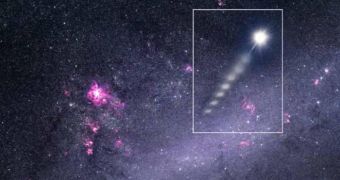In 2005, astronomers discovered a star traveling away from the Milky Way at hypervelocities, thus they argued that it must have somehow been ejected from the central regions of the galaxy during interactions with the supermassive black hole. However, HE 0437-5439 posed a great mystery. How could a 35-million-year-old star travel a distance that would usually take at least 100 million years to complete at the current speed of the star?
Even more intriguing was the fact that light spectroscopy showed that the star had a chemical composition similar to our Sun, suggesting that it too came from the central regions of the Milky Way. Astronomers Alceste Bonanos and Mercedes Lopez-Morales, from the Queens University Belfast, have determined while analyzing the speed, light intensity and chemical compositions, that in fact HE 0437-5439 came from the Large Magellanic Cloud, not from the center of our galaxy, as originally suggested.
Similar to the original presumption, the new study claims that the star has been ejected during gravitational interactions with the supermassive unseen black hole in the center of the Magellanic Cloud. HE 0437-5439 is only one of a total of ten such stars speeding away from our galaxy at incredible speeds. However, it is special compared to the others, since it did not come from the Milky Way.
It is estimated that the speeding star is about nine times the mass of our Sun, and, if indeed it originated from our galaxy, then its age could be explained only through the fact that it might have formed during the merging of two smaller stars. The stars in the Large Magellanic Cloud usually have relatively low metallicity, which could be why astronomers first thought that HE 0437-5439 originated in our galaxy.
The Queens University team concluded that it was moving away from both the Milky Way and the Large Magellanic Cloud with speeds exceeding 2.6 million kilometers per hour. Contrarily to the original study which stated that the star had a chemical composition similar to the stars in our galaxy, astronomers were able to determine that actually it was not the case.
Measurements of its spin speed have shown that the star could originally have been part of a binary system, and was ejected during interactions with a black hole about 1,000 times the mass of the Sun, while its stellar companion was pulled into the black hole's orbit.

 14 DAY TRIAL //
14 DAY TRIAL //